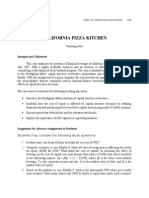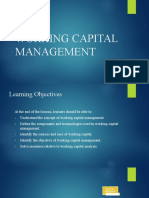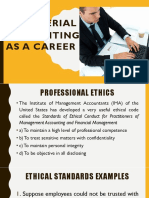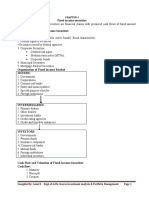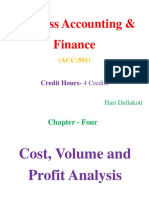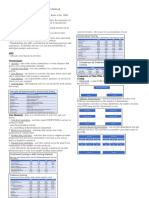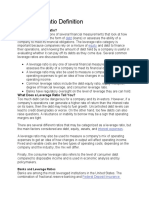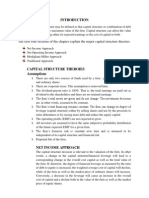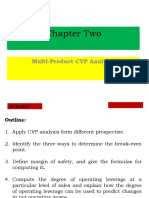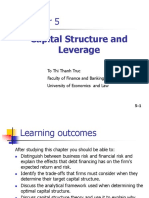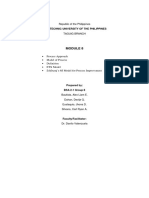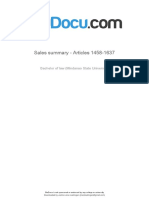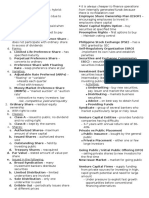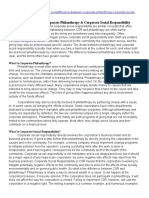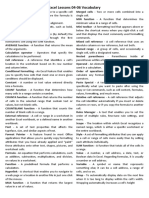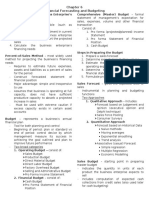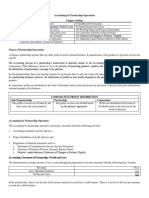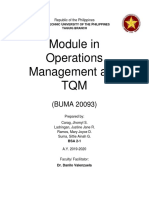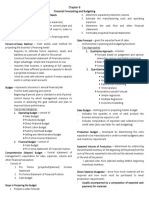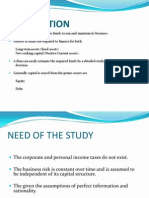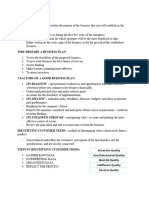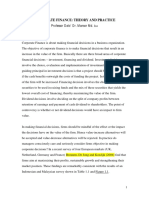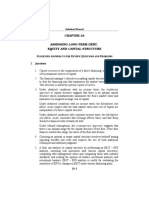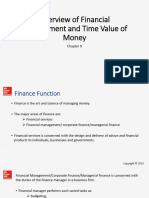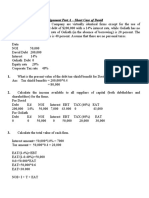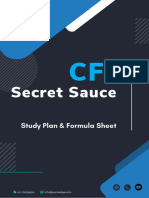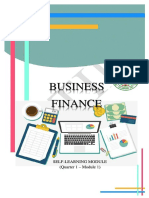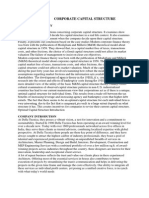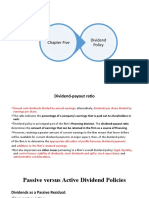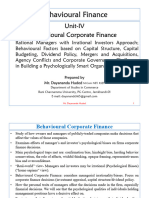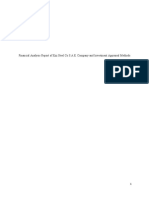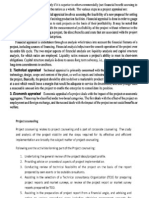0 ratings0% found this document useful (0 votes)
381 viewsChapter 7. Leverage and Capital Structure
Chapter 7. Leverage and Capital Structure
Uploaded by
Jhazz DoLeverage refers to the use of debt in a company's capital structure. There are two types of leverage: operating leverage and financial leverage. Operating leverage measures how fixed operating costs affect profits with changes in sales volume. Financial leverage measures how use of debt versus equity affects risk. The optimal capital structure balances these risks against lowering the overall cost of capital. Managers use tools like break-even analysis and calculating ratios to evaluate leverage and determine the optimal mix of debt and equity.
Copyright:
© All Rights Reserved
Available Formats
Download as DOCX, PDF, TXT or read online from Scribd
Chapter 7. Leverage and Capital Structure
Chapter 7. Leverage and Capital Structure
Uploaded by
Jhazz Do0 ratings0% found this document useful (0 votes)
381 views2 pagesLeverage refers to the use of debt in a company's capital structure. There are two types of leverage: operating leverage and financial leverage. Operating leverage measures how fixed operating costs affect profits with changes in sales volume. Financial leverage measures how use of debt versus equity affects risk. The optimal capital structure balances these risks against lowering the overall cost of capital. Managers use tools like break-even analysis and calculating ratios to evaluate leverage and determine the optimal mix of debt and equity.
Original Title
Chapter 7. Leverage and Capital Structure.docx
Copyright
© © All Rights Reserved
Available Formats
DOCX, PDF, TXT or read online from Scribd
Share this document
Did you find this document useful?
Is this content inappropriate?
Leverage refers to the use of debt in a company's capital structure. There are two types of leverage: operating leverage and financial leverage. Operating leverage measures how fixed operating costs affect profits with changes in sales volume. Financial leverage measures how use of debt versus equity affects risk. The optimal capital structure balances these risks against lowering the overall cost of capital. Managers use tools like break-even analysis and calculating ratios to evaluate leverage and determine the optimal mix of debt and equity.
Copyright:
© All Rights Reserved
Available Formats
Download as DOCX, PDF, TXT or read online from Scribd
Download as docx, pdf, or txt
0 ratings0% found this document useful (0 votes)
381 views2 pagesChapter 7. Leverage and Capital Structure
Chapter 7. Leverage and Capital Structure
Uploaded by
Jhazz DoLeverage refers to the use of debt in a company's capital structure. There are two types of leverage: operating leverage and financial leverage. Operating leverage measures how fixed operating costs affect profits with changes in sales volume. Financial leverage measures how use of debt versus equity affects risk. The optimal capital structure balances these risks against lowering the overall cost of capital. Managers use tools like break-even analysis and calculating ratios to evaluate leverage and determine the optimal mix of debt and equity.
Copyright:
© All Rights Reserved
Available Formats
Download as DOCX, PDF, TXT or read online from Scribd
Download as docx, pdf, or txt
You are on page 1of 2
Chapter 7
Leverage and Capital Structure
Leverage – portion of a business’s fixed cost - Usually lower than break-even point
that represents a risk to the firm = fixed cost MINUS non-cash
Operating Leverage – measure of charges
operating risk = (fixed cost MINUS depreciation)
- Fixed operating costs found in the DIVIDED BY unit CM
income statement B. Operating Leverage – measure of
Financial Leverage – measure of operating risk
financial risk - Arises from the business’s use of fixed
- Long term financing with fixed operating cost
financing charges of business’s - Simple indication = impact of a change
assets in sales on earning before interest and
- Higher financial leverage = higher taxes (EBIT)
financial risk and higher cost of - Operating Leverage at a given
capital Level of Sales (x) = percent change in
* Optimal structure for any business enterprise *EBIT DIVIDED BY percent change in
depends to a great extent on the amount of sales
leverage the business can tolerate and the ( p−v ) x
resultant cost of capital =
( p−v ) x−FC
- *EBIT = (p-v) x - FC
S – Sales C. Financial Leverage – measure of financial
x – Sales Volume per Unit risk
p – Selling Price per Unit - Arises from the presence of debt and/or
v – Unit Variable Cost preference share capital in business’s
VC – Variable Operating Cost capital structure
FC – Fixed Operating Cost - way to measure: determine how earning
per share (EPS) are affected by a change
A. Break-even Analysis – closely related to in EBIT
operating leverage - If EBIT falls = financially leveraged
- Determines *break-even sales business will experience negative
[*financial crossover point at which changes in EPS that are larger than
revenue exactly match costs] relative decline in EBIT
- Important Concepts - Preference share divided must be
Contribution Margin (CM) – adjusted for tax
amount of money available to cover - Financial Leverage at a given Level
fixed cost (FC) and generate profits of Sales (x) = percent change in EPS
- excess of sales (S) over the DIVIDED BY percent change in EBIT
variable cost (VC) ( p−v ) x−FC
= S – VC =
( p−v ) x−FC−I
Unit CM – excess of unit selling price
* I = fixed finance charges
(p) over the unit variable cost (v)
Total Leverage – measure of total risk
=p–v
- To measure: determine how EPS is
a. Break-Even Point – level of sales
affected by a change in sales
revenue that equals to the total of
- Total Leverage at a given Level of
variable and fixed costs for any given
Sales (x)
volume of output at a particular capacity
= percent change in EPS DIVIDED BY
use rate
percent change in sales
- Lower BEP = higher profits and less
= operating leverage MULTIPLIED BY
operating risk
financial leverage
- Break-Even Points in Units = fixed
cost DIVIDED BY unit CM ( p−v ) x ( p−v ) x −FC
= ×
b. Cash Break-Even Point – necessary ( p−v ) x−FC ( p−v ) x−FC −I
sales to cover all cash expenses during ( p−v )x
=
the period ( p−v ) x−FC −1
- Not all fixed operating cost involve
cash payment (e.g. depreciation) Tools of Capital Structure Management
* Capital Structure Management – mix of - Can be used for two types of
long-term funding source used by business comparison
- To maximize market value of business i. Can compare past and expected
- Optimal Capital Structure – mix, future ratios for the same
minimizes the overall cost of capital business in order to determine if
o Not all financial managers believe that there has been improvement or
this actually exists deterioration in coverage over
o May allow a higher portion of debt to time
equity than actual industry average = ii. To evaluate capital structure of
justify more debt than industry other businesses in the same
- Decision to use debt and/or preference industry
share in capitalization results in two types of - Common Ratios
financial leverage effect a. Time Interested Earned – most
i. Increased risk to EPS caused by the use widely used comparative ratio
of financial obligations - Reveals nothing about
ii. Relates to the level of EPS at a given business’s ability to meet
EBIT under a specific capital structure principal payments on its debt
- Tools = EBIT DIVIDED BY interest on
1. EBIT-EPS Analysis – practical tool that debt
enables financial managers to evaluate b. Debt-Service Coverage –
alternative financing plans by investing coverage ratio for full debt-service
their effect on EPS for a range of EBIT burden
levels EBIT
- Primary objective: determine the EBIT = Principal Payments
Interest 1+
break-even or indifference points at 1−Tax rate
which the EPS will be the same * Financial risk associated with leverage should
regardless of the financing plan be analyzed of the business’s ability to service
- EBIT amount > EBIT indifference level total fixed charges
= more highly leveraged financing * Lease financing is NOT a debt, but it has
plan will generate higher EPS same impact on cash flow.
- EBIT amount < EBIT indifference level
= financing plan involving least Factors that Influence Capital Structure
leverage will generate higher EPS 1. Growth rate and stability of future sales
= 2. Competitive structure in the industry
(EBIT −I )(1−t)PD ( EBIT −I )(1−t) PD 3. Asset makeup of individual firm
= 4. The business risk which the firm is exposed
S1 S2
2. Analysis of Cash Flow – to determine 5. Control status of owners and management
the ability to service fixed charges 6. Lenders’ attitudes toward the industry and
- Greater peso amount of debt and/or the business
preference share capital the business Factors that Affect the Level of Target
issues and the shorter their maturity Debt Ratio
= greater fixed charges the business Main: Business’s ability to service fixed
will have to bear financing costs
- Before assuming additional charges, Other:
business should analyze its future a. Maintaining a desired bond rating
expected future cash flows b. Providing an adequate borrowing reserve
o Inability to meet future charges = c. Exploiting the advantages of financial
leverages
insolvency
- Greater and more stable expected
future cash flow = greater debt
capacity
3. Calculation of Comparative
Coverage Ratio – corporate financial
officer typically uses as EBIT as a rough
measure of the cash flow available to
cover debt-servicing obligation
You might also like
- TN33 California Pizza KitchenDocument8 pagesTN33 California Pizza KitchenToday100% (2)
- (TEST BANK and SOL) Current LiabilitiesDocument5 pages(TEST BANK and SOL) Current LiabilitiesJhazz Do100% (1)
- Associate Co. QuestionsDocument3 pagesAssociate Co. QuestionsSigei Leonard100% (2)
- (TEST BANK and SOL) Bonds PayableDocument6 pages(TEST BANK and SOL) Bonds PayableJhazz DoNo ratings yet
- Annamalai UniversityDocument392 pagesAnnamalai UniversitySmiles PrintingNo ratings yet
- Makerere University College of Business and Management Studies Master of Business AdministrationDocument15 pagesMakerere University College of Business and Management Studies Master of Business AdministrationDamulira DavidNo ratings yet
- WORKING CAPITAL MANAGEMENT - Concepts and Policy With MarkingsDocument41 pagesWORKING CAPITAL MANAGEMENT - Concepts and Policy With MarkingsBoa HancockNo ratings yet
- Ayala Land Strategy PaperDocument3 pagesAyala Land Strategy Papercamilaluis97No ratings yet
- CHAPTER 2 Joint VentureDocument5 pagesCHAPTER 2 Joint VentureAkkamaNo ratings yet
- MODULE 3 PPT Managerial Accounting As A CareerDocument27 pagesMODULE 3 PPT Managerial Accounting As A CareerAnnabel SenitaNo ratings yet
- Accounting For Foreign Currency TransactionsDocument16 pagesAccounting For Foreign Currency TransactionsAaron AraulaNo ratings yet
- Decision Making and Relevant Information: Learning ObjectivesDocument14 pagesDecision Making and Relevant Information: Learning ObjectivesKelvin John RamosNo ratings yet
- Chapter 6 - Bond ValuationDocument46 pagesChapter 6 - Bond ValuationHarith DaniealNo ratings yet
- KF Cost Volume Profit AnalysisDocument43 pagesKF Cost Volume Profit AnalysisNCTNo ratings yet
- Definition of Cost and CostingDocument6 pagesDefinition of Cost and CostingNahidul Islam IUNo ratings yet
- Chap12 (Capital Budgeting and Estimating Cash Flows) VanHorne&Brigham, CabreaDocument4 pagesChap12 (Capital Budgeting and Estimating Cash Flows) VanHorne&Brigham, CabreaClaudine DuhapaNo ratings yet
- CHAPTER 3 Corrent LiabilityDocument25 pagesCHAPTER 3 Corrent LiabilityTesfaye Megiso BegajoNo ratings yet
- FM Unit 4 Lecture Notes - Time Value of MoneyDocument4 pagesFM Unit 4 Lecture Notes - Time Value of MoneyDebbie DebzNo ratings yet
- Reviewer in Financial MarketDocument6 pagesReviewer in Financial MarketPheobelyn EndingNo ratings yet
- Corporation Accounting - IntroductionDocument8 pagesCorporation Accounting - IntroductionRichard LeightonNo ratings yet
- Chapter 7 - Portfolio inDocument12 pagesChapter 7 - Portfolio intemedebereNo ratings yet
- Public Finance & Taxation - Chapter 4, PT IVDocument24 pagesPublic Finance & Taxation - Chapter 4, PT IVbekelesolomon828100% (1)
- IFE MatrixDocument2 pagesIFE MatrixGraciella Tiffany100% (3)
- Ch. 15 - Capital Structure & LeverageDocument45 pagesCh. 15 - Capital Structure & LeverageLara FloresNo ratings yet
- Corporate Debt Market: Developments, Issues & Challenges: Efficient Allocation of ResourcesDocument11 pagesCorporate Debt Market: Developments, Issues & Challenges: Efficient Allocation of ResourcesManmeetSinghNo ratings yet
- CHAPTER - 5 Capital Budgeting & Investment DecisionDocument40 pagesCHAPTER - 5 Capital Budgeting & Investment Decisionethnan lNo ratings yet
- Share-Based Compensation: Learning ObjectivesDocument48 pagesShare-Based Compensation: Learning ObjectivesJola MairaloNo ratings yet
- M1 - Introduction To Valuation HandoutDocument6 pagesM1 - Introduction To Valuation HandoutPrince LeeNo ratings yet
- FM - Dividend Policy and Dividend Decision Models (Cir 18.3.2020)Document129 pagesFM - Dividend Policy and Dividend Decision Models (Cir 18.3.2020)Rohit PanpatilNo ratings yet
- Overview of Financial ManagementDocument16 pagesOverview of Financial ManagementKAUSHIKNo ratings yet
- ACC..ch 5 Sec..2Document87 pagesACC..ch 5 Sec..2Utban AshabNo ratings yet
- Prepared by Coby Harmon University of California, Santa Barbara Westmont CollegeDocument38 pagesPrepared by Coby Harmon University of California, Santa Barbara Westmont Collegee s tNo ratings yet
- Balance Sheet and Statement of Cash Flows: Intermediate Accounting 12th Edition Kieso, Weygandt, and WarfieldDocument46 pagesBalance Sheet and Statement of Cash Flows: Intermediate Accounting 12th Edition Kieso, Weygandt, and WarfieldGisilowati Dian PurnamaNo ratings yet
- Chapter Six: Pricing Decisions AND Cost ManagementDocument39 pagesChapter Six: Pricing Decisions AND Cost ManagementEbsa AbdiNo ratings yet
- CHAPTER 5 - Portfolio TheoryDocument58 pagesCHAPTER 5 - Portfolio TheoryKabutu ChuungaNo ratings yet
- 16 Difference Between Financial Audit and Forensic AuditDocument1 page16 Difference Between Financial Audit and Forensic AuditVenkatsubramanian R IyerNo ratings yet
- Invest Chapter 4Document9 pagesInvest Chapter 4Dere GurandaNo ratings yet
- CVP Analysis - PPT (Autosaved)Document33 pagesCVP Analysis - PPT (Autosaved)Anonymous gDxeGLYNo ratings yet
- FM 02-Financial Markets and Institutions The Process of Capital AllocationDocument3 pagesFM 02-Financial Markets and Institutions The Process of Capital AllocationJPIA Scholastica DLSPNo ratings yet
- Baumol Miller Orr Cash MGMT Models QDocument4 pagesBaumol Miller Orr Cash MGMT Models QPrecious Diamond DeeNo ratings yet
- The Cost of Capital: All Rights ReservedDocument56 pagesThe Cost of Capital: All Rights ReservedANISA RABANIANo ratings yet
- TOPIC 6 - Responsibility AccountingDocument1 pageTOPIC 6 - Responsibility AccountingAnthony OtiatoNo ratings yet
- Ch19 Capital Budgeting DecisionsDocument2 pagesCh19 Capital Budgeting DecisionsRebecca LumanasNo ratings yet
- Chapter 6 Activity Based CostingDocument1 pageChapter 6 Activity Based CostingKaren Cael100% (1)
- FINMNN1 Chapter 4 Short Term Financial PlanningDocument16 pagesFINMNN1 Chapter 4 Short Term Financial Planningkissmoon732No ratings yet
- Public Chapter 4Document19 pagesPublic Chapter 4samuel debebeNo ratings yet
- Cost Behavior Analysis and UseDocument3 pagesCost Behavior Analysis and Usepablopaul56No ratings yet
- T1 Introduction (Answer)Document5 pagesT1 Introduction (Answer)Wen Kai YeamNo ratings yet
- CH 4Document23 pagesCH 4Gizaw BelayNo ratings yet
- Thrift Operations: Financial Markets and Institutions, 7e, Jeff MaduraDocument30 pagesThrift Operations: Financial Markets and Institutions, 7e, Jeff MaduraKevin NicoNo ratings yet
- Internal AnalysisDocument12 pagesInternal AnalysisKirabo Ivy MarthaNo ratings yet
- Leverage Ratio DefinitionDocument3 pagesLeverage Ratio DefinitionNiño Rey LopezNo ratings yet
- Chapter Four: Insurance ContractsDocument14 pagesChapter Four: Insurance ContractstalilaNo ratings yet
- Financial Management Chapter 03 FMDocument13 pagesFinancial Management Chapter 03 FMbikilahussenNo ratings yet
- Difference Between Joint Venture and ConsignmentDocument1 pageDifference Between Joint Venture and ConsignmentAbhiRishi100% (1)
- Introduction of Capital StructureDocument3 pagesIntroduction of Capital StructureshivavishnuNo ratings yet
- Capital BudgetingDocument10 pagesCapital BudgetingAkatsuki no YonaNo ratings yet
- Chapter 2-Multi-Product CVP AnalysisDocument53 pagesChapter 2-Multi-Product CVP AnalysisAyeNo ratings yet
- Topic 7 - Cost-Volume-Profit Analysis (Student Version)Document28 pagesTopic 7 - Cost-Volume-Profit Analysis (Student Version)Nur afiqahNo ratings yet
- Research: Methods in Accounting and Finance (ACFN2131)Document36 pagesResearch: Methods in Accounting and Finance (ACFN2131)Yoseph KassaNo ratings yet
- Non-Current Asset Held For SaleDocument28 pagesNon-Current Asset Held For SaleTrisha Mae AlburoNo ratings yet
- Chapter 3 Conceptual FrameworkDocument13 pagesChapter 3 Conceptual FrameworkWeirdNo ratings yet
- Chapter 5 Leverage Capital Structure - V2 FM14Document98 pagesChapter 5 Leverage Capital Structure - V2 FM14Yến NhiNo ratings yet
- Using Costs in Decision Making: Pricing - Cost Can Determine If A Firm CanDocument10 pagesUsing Costs in Decision Making: Pricing - Cost Can Determine If A Firm Cansneha mallikaNo ratings yet
- Law Summary The Law On Sales Agency and Credit TransactionsDocument8 pagesLaw Summary The Law On Sales Agency and Credit TransactionsJhazz DoNo ratings yet
- Module III. LeadershipDocument21 pagesModule III. LeadershipJhazz DoNo ratings yet
- Module 8 Process ApproachDocument6 pagesModule 8 Process ApproachJhazz Do100% (2)
- Sales Summary - Articles 1458-1637 Sales Summary - Articles 1458-1637Document5 pagesSales Summary - Articles 1458-1637 Sales Summary - Articles 1458-1637Jhazz Do100% (2)
- Chapter 12. Long Term Equity FinancingDocument2 pagesChapter 12. Long Term Equity FinancingJhazz DoNo ratings yet
- CSR As Corporate PhilantrophyDocument3 pagesCSR As Corporate PhilantrophyJhazz DoNo ratings yet
- Excel Vocabulary - Chapter 4-6Document2 pagesExcel Vocabulary - Chapter 4-6Jhazz DoNo ratings yet
- Chapter 6. Financial Forecasting and BudgetingDocument2 pagesChapter 6. Financial Forecasting and BudgetingJhazz DoNo ratings yet
- (TEST BANK and SOL) Bonds PayableDocument6 pages(TEST BANK and SOL) Bonds PayableJhazz DoNo ratings yet
- Leadership and TQMDocument17 pagesLeadership and TQMJhazz DoNo ratings yet
- Chapter 4 Accounting For Partnership OperationsDocument35 pagesChapter 4 Accounting For Partnership OperationsJhazz Do100% (3)
- Module III. LeadershipDocument22 pagesModule III. LeadershipJhazz DoNo ratings yet
- Chapter 6. Financial Forecasting and BudgetingDocument2 pagesChapter 6. Financial Forecasting and BudgetingJhazz Do100% (1)
- Risk Management PDFDocument1,007 pagesRisk Management PDFsemarasik_651536604No ratings yet
- Chapter 13Document66 pagesChapter 13Nguyen Hai AnhNo ratings yet
- Chapter - 2 Review of LiteratureDocument34 pagesChapter - 2 Review of LiteraturesathiyaNo ratings yet
- NESTLE BHD Financial Analysis: Group 4Document14 pagesNESTLE BHD Financial Analysis: Group 4Ct TanNo ratings yet
- Capital Structure Power Point PresentationDocument6 pagesCapital Structure Power Point Presentationmohammedakbar88No ratings yet
- Business Plan RealDocument6 pagesBusiness Plan RealAtasha MojecaNo ratings yet
- Artikel-Corporate Finance-Theory and PracticeDocument29 pagesArtikel-Corporate Finance-Theory and PracticeBagus SetyawanNo ratings yet
- Assessing Long-Term Debt, Equity and Capital Structure: S A R Q P I. QuestionsDocument9 pagesAssessing Long-Term Debt, Equity and Capital Structure: S A R Q P I. QuestionsJp CombisNo ratings yet
- Aksujomas 03 01 05Document20 pagesAksujomas 03 01 05Rasaq MojeedNo ratings yet
- CH 9 Introduction To Financial ManagementDocument27 pagesCH 9 Introduction To Financial ManagementVansh manojNo ratings yet
- Capital Structure Analysis of Hero HondaDocument8 pagesCapital Structure Analysis of Hero HondaHari ShankarNo ratings yet
- Assignment Part A - Short Case of DavidDocument6 pagesAssignment Part A - Short Case of DavidZUBAIR100% (2)
- Cap StructureDocument3 pagesCap StructureRiya GargNo ratings yet
- CFA Secret Sauce QuintedgeDocument23 pagesCFA Secret Sauce QuintedgejagjitbhaimbbsNo ratings yet
- Financial Accounting - Group ReportingDocument18 pagesFinancial Accounting - Group ReportingPravallika RavikumarNo ratings yet
- Module 1 Business FinanceDocument42 pagesModule 1 Business FinanceEdna MingNo ratings yet
- Assignments FMDocument7 pagesAssignments FMPrachi Bajaj100% (1)
- Corporate Capital StructureDocument14 pagesCorporate Capital StructurepothigaiselvansNo ratings yet
- Leverage MaterialsDocument9 pagesLeverage MaterialsArnnava SharmaNo ratings yet
- C-5 Dividend Policy 3rdDocument12 pagesC-5 Dividend Policy 3rdsamuel debebeNo ratings yet
- Lucky Cement Strategic OptionsDocument5 pagesLucky Cement Strategic OptionsFahim QaiserNo ratings yet
- Exam1 FIN370 Winter 2009 - A KeyDocument25 pagesExam1 FIN370 Winter 2009 - A KeyPhong NguyenNo ratings yet
- Leverage and Capital StructureDocument8 pagesLeverage and Capital StructureC H ♥ N T ZNo ratings yet
- Behavioral Finance CorporateDocument27 pagesBehavioral Finance Corporatesumesh balakrishnanNo ratings yet
- Ezz Steel Report.eDocument14 pagesEzz Steel Report.eIsrael Sodium JobNo ratings yet
- Project AppraisalDocument29 pagesProject AppraisalsaravmbaNo ratings yet
- Capital StructureDocument26 pagesCapital StructureN ArunsankarNo ratings yet
- Weighted Average Cost of CapitalDocument20 pagesWeighted Average Cost of CapitalSamuel NjengaNo ratings yet
